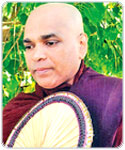|
Lesson for mindfulness – part 6:
How to tackle with
negative emotions
 Battaramulla Battaramulla
Siri Sudassanarama
sadaham senasuna
Ven. Dr. Mirisse Dhammika thero
As a first step of Bhavana, when students are mindful of their breath, it helps
them to calm the mind and the body. This calmness of the mind and the body helps
them to be aware of emotions and feelings with a greater clarity. Whenever
feelings arise, students can become aware of these feelings and how they change.
 For instance, if students are aware that their anger is rising up, and they can
bring mindful-attention to that fact, then they will have the opportunity to
control action out the anger. Also, in mindfulness one becomes aware of how
anger arises, stays awhile and disbands, and that it is not permanent. This may
lead students to calm their minds. Many students gets stressed or troubled or
become violent due to uncontrolled anger or ill-will (Stilwell, Galvin, Kopta,
Swick). Itseems that they may not be “aware” of their anger before they express
it in an outburst, and that they only realize it after they express it. Clearly,
this type of self-observation cannot be practical for most small children, say
around five- years-old, due to an undeveloped cognition at this stage
(Crittenden,) but it may help restless teenaged students get rid of uncontrolled
negative feelings as I mentioned above. For instance, if students are aware that their anger is rising up, and they can
bring mindful-attention to that fact, then they will have the opportunity to
control action out the anger. Also, in mindfulness one becomes aware of how
anger arises, stays awhile and disbands, and that it is not permanent. This may
lead students to calm their minds. Many students gets stressed or troubled or
become violent due to uncontrolled anger or ill-will (Stilwell, Galvin, Kopta,
Swick). Itseems that they may not be “aware” of their anger before they express
it in an outburst, and that they only realize it after they express it. Clearly,
this type of self-observation cannot be practical for most small children, say
around five- years-old, due to an undeveloped cognition at this stage
(Crittenden,) but it may help restless teenaged students get rid of uncontrolled
negative feelings as I mentioned above.
 Although an individual may control their negative feelings in a particular
incident, those same feelings may arise again when the environment or situation
changes. When that person is mindful of the impermanent nature of those negative
things, and that these negative emotions can be harmful to oneself as well as to
others, one may remain calm, regardless of the specific situation, environment
or the people involved. Gunaratana notes: “breathing is a universal process. All
vertebrates breathe in essentially the same manner. All living things exchanges
gases with their environment in some way or others.” Therefore, breathing Although an individual may control their negative feelings in a particular
incident, those same feelings may arise again when the environment or situation
changes. When that person is mindful of the impermanent nature of those negative
things, and that these negative emotions can be harmful to oneself as well as to
others, one may remain calm, regardless of the specific situation, environment
or the people involved. Gunaratana notes: “breathing is a universal process. All
vertebrates breathe in essentially the same manner. All living things exchanges
gases with their environment in some way or others.” Therefore, breathing
Bhavana can be used by everyone to help them to observe their feelings
mindfully. Teaching the ‘mindfulness on the breath’ technique as a first step of
Bhavana may help students to practice self-discipline.
In the beginning, one will find that it is not easy to bring the mind to
concentrate on breathing even for a few seconds. Students will be amazed to see
how the mind becomes distracted, by external sounds and internal conditions such
as racing thoughts. They may be frustrated and disappointed by these
disturbances and distractions. Even so if they continue this practice at lease
once daily, morning or evening, for about five to ten minutes at a time, without
giving up their effort, they will gradually begin to concentrate the mind on
their breathing (Santina). After a certain period, depending on their own
ability and determination, they will experience a fully concentrated and
peaceful mind.
Although they still have to go on practicing this regularly, and it is important
to know that they must have determination and persistence to achieve the goal.
This practice of mindfulness of breathing is one of the simplest and easiest
techniques for students or anybody at the beginning (Kabat-Zin, Gunaratana). At
moments when they are nervous or excited, such as when taking exams or giving a
speech, they can practice mindfulness for a few minutes and they will see for
themselves that they become calm and better able to deal with difficult
situations
(Segal,
Williams & Teasdale, Rahula). |